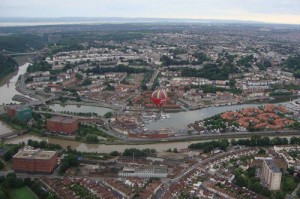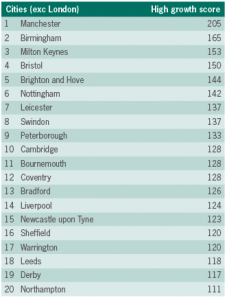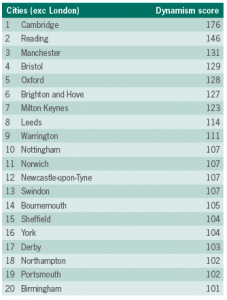Bristol has been named as one of the UK’s top five cities for growth outside of London, underpinning its reputation as a centre for innovation, technology and creativity.
The city ranks fourth for economic and demographic expansion over the past eight years, according to a new report analysing the performance of English towns and cities. 
And it stands at fourth in a table that identifies areas with “vibrant and dynamic” economies capable of supporting future expansion.
The report, based on accountants Grant Thornton’s High Growth Index, ranks English cities and districts according to their recent growth and potential for further, sustainable expansion.
Bristol has a ‘high growth score’ of 150, according the index, ranking it fourth in the list of growth cities, which is headed by Manchester with a score of 205. Birmingham and Milton Keynes are second and third.
The ‘forward-looking’ table is headed by Cambridge with a ‘dynamism score’ of 176. Bristol, in fourth place, scores 129 behind Reading and Manchester.
The report also identifies a number of ‘growth corridors’, including an area stretching along the M4 from Swindon to Bristol.
It shows that England’s high-growth and dynamic areas share certain characteristics – the presence of high-value, knowledge-intensive businesses, a supportive environment for enterprise, and diverse communities with a young and economically active workforce, coupled with strong transport and IT connectivity. 
Grant Thornton’s head of public sector assurance in the South West, John Golding, pictured, said: “The High Growth Index raises a number of interesting questions about current economic policy, as London makes up around half of the 50 top performing districts.
“The focus needs to be on re-balancing the economy and creating economic scale to drive sustainable growth outside of the capital, as much as within it.
“The growth corridors identified by the report highlight a number of implications for those local authorities and LEPs (local enterprise partnerships), both in and out of these corridors.
“For local economies, like Bristol and Swindon, which are within a growth corridor, it’s vital that leaders and economic stakeholders collaborate to manage and deliver growth in a joined-up and complementary way, and also consider their local strengths and assets in a broader context, be that human capital or local amenities.”
Bristol is fourth in the ranking of English cities that have continued to grow over the past eight years (left-hand chart below) and also fourth among those with further dynamic growth potential (right-hand chart below)































